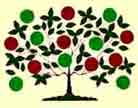Hancock Shaker Village:
The Hancock
Shaker Village, located in Hancock, Massachusetts was opened in 1790 and was known
as the Pittsfield-Hancock Community. The village is recognizable by its round stone barn. This round barn is the only round
barn built by Shakers. It is a classic example of the ingenuity and functionality of design which is often associated with
the Shakers. In 1960, the village was closed by the central Shaker Ministry and sold for $125,000 with the understanding that
the village would become a museum. Hancock was the third to last of the Shaker villages to be closed as active communities.
Today the village is made up of twenty historic buildings which are set among farm and woodland. The village also possesses
a collection of 22,200 objects including a library complete which contains 13,000 primary and secondary sources. The Village
is open for both guided and self-guided tours from April until October, and then from November until April the guided tours
are available by appointment.
Pleasant Hill:
In the year 1805 three Shaker
missionaries traveled from New England down to Kentucky
where they met Elisha Thomas. Thomas would soon become one of the first in Kentucky
to become a Believer. As more people in the area became interested in the Shaker message, the 140 acre farm belonging to Elisha
Thomas became the home to the family of Shakers, known as the Pleasant Hill Shakers. In December of 1806 the first family
covenant was signed by 44 people. Within two years the family had out-grown their original location and moved to a hilltop
that would become known shortly as Pleasant Hill. They began
to construct a permanent village. By 1823 there were 491 Believers living at the village which consisted of 4,500 acres of
land. Before the village was closed in 1901 the Shakers at Pleasant Hill
had built 260 various structures, of which 34 remain today. When the last Shaker at the village passed away the buildings
and land passed into private hands. Today the village is a National Historical Landmark. The majority of the remaining 34
Shaker buildings are part of a living history museum which is open year round. Visitors can explore the village in both guided
and self-guided tours. Scattered throughout the village are costumed interpreters waiting to share the history of the village
and the Shakers with the various visitors.
Canterbury:
Canterbury
Shaker Village, located in Canterbury, New Hampshire was founded in 1792 and was the
seventh Shaker community to be established. The village was the home of the Central Shaker Ministry and remained open until
1992 when the last Shaker sister there died. This was the last village to be closed, leaving the Sabbathday Lake Shaker
Village the only active community remaining. Since 1992 the village,
which sits on 694 acres of land, has operated as museum. The site consists of twenty five restored and four reconstructed
buildings. This includes the only remaining intact first generation meeting and dwelling house. The Meeting House was built
in 1792 and the Dwelling House in 1793. Today the village is host to a variety of collections, workshops, and other events.
Mount Lebanon:
The
Mount Lebanon community was the first Shaker village to be established after Niskeyuna. Located
in Mount Lebanon, New York,
the village was first founded in the 1780’s. It was from the Mount Lebanon
Village that the influential Shaker leader Joseph Meacham began to establish
the sense of community and organization which became an integral part of the Shaker religion. In 1947 the last seven Shakers
of Mount Lebanon left the village and the property and buildings passed into the hands of a private owner. The village, which
is known for its great stone barn, measuring fifty feet wide, two hundred feet long, and four stories high, was named a National
Historic Landmark in the year 1965. In 1972 the barn was completely destroyed by fire, with the exception of the four massive
stone walls. The Mount Lebanon Village
has since been placed on the National Park Service’s list of endangered sites. There is currently a plan to raise money
to renovate the barn and turn it into a museum.

